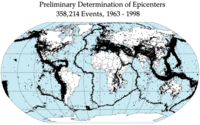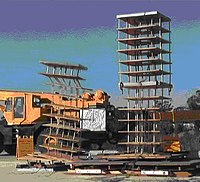
Energy-based seismic collapse criterion for ductile planar structural frames
Sign Up to like & getrecommendations! Published in 2017 at "Engineering Structures"
DOI: 10.1016/j.engstruct.2017.02.051
Abstract: Abstract One of the most common approaches to assess the collapse capacity of structures under earthquakes is incremental dynamic analysis (IDA), which tracks relationship between a structural damage measure and a ground motion intensity measure… read more here.
Keywords: criterion; collapse; based seismic; energy based ... See more keywords

Evaluation of deformation-based seismic performance of RECC frames based on IDA method
Sign Up to like & getrecommendations! Published in 2020 at "Engineering Structures"
DOI: 10.1016/j.engstruct.2020.110499
Abstract: Abstract Engineered Cementitious Composites (ECC) is a typical High Performance Fiber Reinforced Cement-based Composite (HPFRCC), which possesses the characteristics of ultra-high tensile ductility and energy dissipation capacity. One of the potential applications of ECC is… read more here.
Keywords: deformation; based seismic; performance; seismic performance ... See more keywords

Exploring the possibility of assessing the damage degree of liquefaction based only on seismic records by artificial neural networks
Sign Up to like & getrecommendations! Published in 2021 at "Soils and Foundations"
DOI: 10.1016/j.sandf.2021.01.014
Abstract: Abstract This study presents a new approach to determine the damage degree of liquefaction caused by a large earthquake. We propose an artificial neural network (ANN) model based only on the seismic records of ground… read more here.
Keywords: degree liquefaction; based seismic; damage; seismic records ... See more keywords

Scenario-Based Seismic Risk Assessment for Buried Transmission Gas Pipelines at Regional Scale
Sign Up to like & getrecommendations! Published in 2018 at "Journal of Pipeline Systems Engineering and Practice"
DOI: 10.1061/(asce)ps.1949-1204.0000330
Abstract: AbstractBuried gas pipelines in seismic-prone regions may suffer leaks or breaks as a consequence of an earthquake, especially if the pipeline is subjected to large differential displacements due t... read more here.
Keywords: gas pipelines; risk assessment; scenario based; gas ... See more keywords

Proposed Updates to the ASCE 41 Nonlinear Modeling Parameters for Wide-Flange Steel Columns in Support of Performance-Based Seismic Engineering
Sign Up to like & getrecommendations! Published in 2019 at "Journal of Structural Engineering"
DOI: 10.1061/(asce)st.1943-541x.0002353
Abstract: AbstractNonlinear static and dynamic analyses are utilized by engineers for performance-based seismic risk evaluation of new and existing structures. In this context, nonlinear component modeling c... read more here.
Keywords: proposed updates; engineering proposed; performance based; based seismic ... See more keywords

Equivalent Damping Ratio Equations in Support of Displacement-Based Seismic Design for Pile-Supported Wharves
Sign Up to like & getrecommendations! Published in 2017 at "Journal of Earthquake Engineering"
DOI: 10.1080/13632469.2016.1172377
Abstract: This study primarily proposes new equivalent damping ratio equations based on Jacobsen’s approach for displacement-based seismic design of pile-supported wharves to account for wharf configurations and soil-pile interaction. It is found that Pivot hysteresis model… read more here.
Keywords: seismic design; damping ratio; based seismic; displacement based ... See more keywords

Performance-based Seismic Risk Assessment of Urban Systems
Sign Up to like & getrecommendations! Published in 2018 at "International Journal of Architectural Heritage"
DOI: 10.1080/15583058.2018.1503371
Abstract: ABSTRACT Disaster risk mitigation has become a urgent global need. Similar to other natural hazards, earthquakes may cause significant damage on a large scale. In Europe and in other regions with dense urbanization, seismic events… read more here.
Keywords: risk; risk assessment; seismic risk; based seismic ... See more keywords

Debris-flow velocity and volume estimations based on seismic data
Sign Up to like & getrecommendations! Published in 2021 at "Natural Hazards and Earth System Sciences"
DOI: 10.5194/nhess-2020-411
Abstract: Abstract. The estimation of debris-flow velocity and volume is a fundamental task for the development of early warning systems, the design of control structures and other mitigation measures. Previous analysis of the seismic energy produced… read more here.
Keywords: flow velocity; seismic data; based seismic; debris flow ... See more keywords